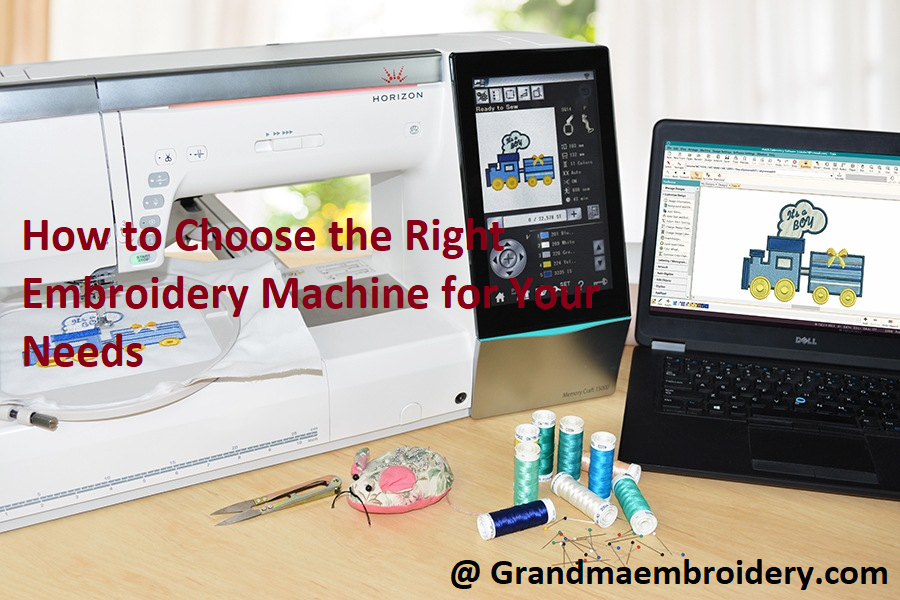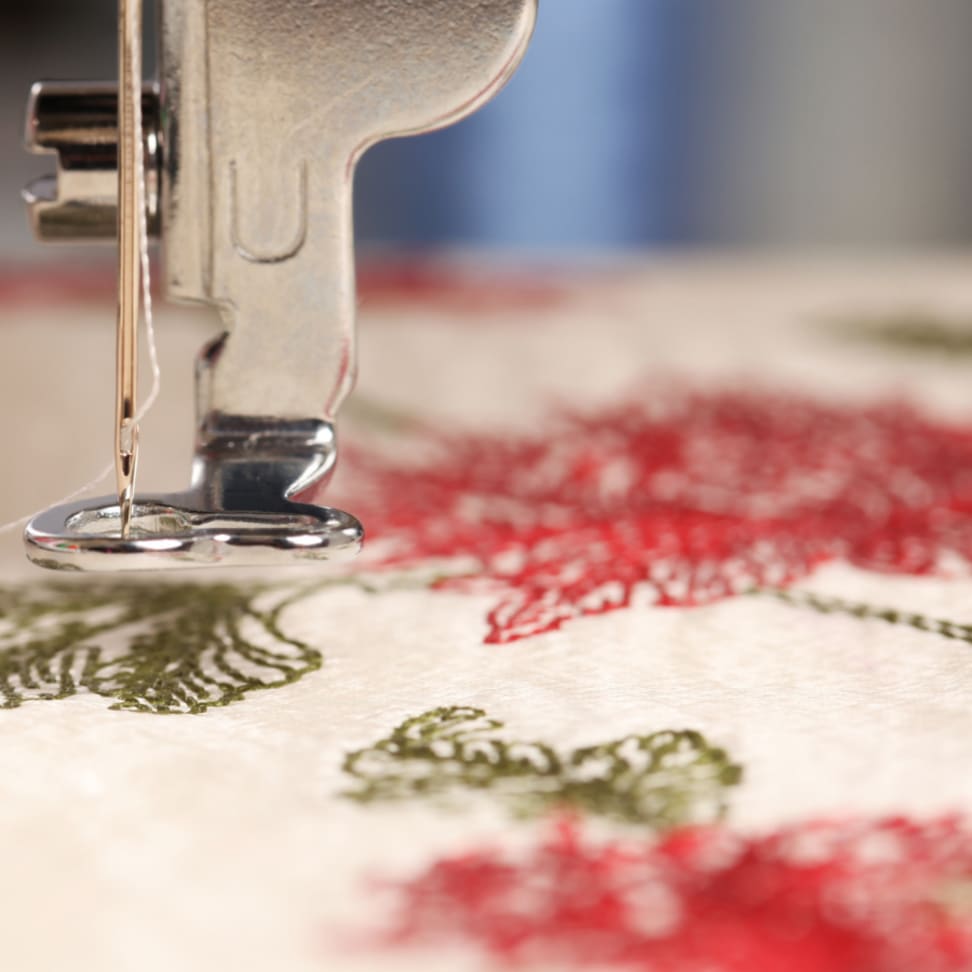Introduction
Embroidery machines are specialized devices that allow users to create intricate and detailed designs on a variety of fabrics and materials. These machines use computer-controlled technology to precisely stitch thread onto fabric, allowing for a high level of accuracy and consistency in the final product.
Choosing the right embroidery machine is essential for anyone looking to create high-quality embroidered designs. Factors to consider when selecting a machine include the size and type of embroidery hoop, the number of needles and stitches per minute the machine can produce, and the level of automation and customization available.

With the right embroidery machine, users can produce professional-grade embroidered designs quickly and easily, allowing them to bring their creative vision to life in a variety of applications, from custom apparel and home decor to commercial products and gifts.
Factors to consider before buying an embroidery machine
When considering purchasing an embroidery machine, there are several factors to take into account to ensure that you choose the right one for your needs:
Budget: Embroidery machines can vary greatly in price, so it’s important to establish a budget and stick to it. More expensive machines tend to have more features and capabilities, but there are still many great options available at lower price points.
Purpose: What do you plan to use the embroidery machine for? Are you creating designs for personal use or do you plan to use it for commercial purposes? Different machines may be better suited for different purposes, so it’s important to identify your intended use.
Skill level: Consider your skill level when selecting an embroidery machine. Some machines may be more user-friendly and intuitive, while others may require more advanced knowledge and experience to operate effectively.
Type of embroidery projects: The type of embroidery projects you plan to create will influence the type of machine you choose. Some machines are better suited for smaller, more intricate designs, while others are designed to handle larger and more complex projects.
Size and weight of the machine: Consider the size and weight of the machine, as well as the space you have available for it. Larger machines may offer more capabilities, but they may also be more cumbersome to move and store.
Brand and model reputation: Research different brands and models of embroidery machines to identify which have a good reputation for quality, reliability, and customer support.
Warranty and customer support: Make sure to check the warranty and customer support offered with the machine, as this can help ensure that any issues or problems are addressed quickly and effectively.
III. Types of embroidery machines
There are three main types of embroidery machines available on the market:
Mechanical embroidery machines: These machines are the most basic type of embroidery machine and are operated manually, using knobs and dials to adjust the stitching. They are often less expensive than computerized machines, but offer fewer features and capabilities.
Computerized embroidery machines: These machines are equipped with computer technology that allows the user to design and edit embroidery patterns digitally. They offer a wide range of features, such as automatic thread cutting, color changing, and design scaling. Computerized embroidery machines tend to be more expensive than mechanical machines, but offer a higher degree of precision and customization.

Combination embroidery machines: As the name suggests, these machines combine both mechanical and computerized capabilities, allowing users to operate the machine manually or through computerized software. This type of machine offers greater versatility and flexibility, as well as the ability to create more complex designs. However, they are also typically more expensive than either mechanical or computerized machines alone.
Features to look for in an embroidery machine
When shopping for an embroidery machine, there are several features to look for that can impact the machine’s performance and your ability to create high-quality designs:
Hoop size: The hoop size determines the maximum embroidery area that the machine can accommodate. Look for a machine with a hoop size that is appropriate for the types of projects you plan to create.
Number of needles: The number of needles a machine has will determine how many colors you can use in a single design. If you plan to create designs with a lot of color variation, look for a machine with multiple needles.
Built-in designs: Many embroidery machines come with pre-installed designs that you can use as a starting point for your own creations. Look for a machine with a variety of built-in designs that match your style and interests.
Editing capabilities: Some embroidery machines allow you to edit designs directly on the machine, such as resizing, rotating, and flipping. Look for a machine with editing capabilities that match your skill level and the complexity of the designs you plan to create.
Connectivity options: Some embroidery machines allow you to connect to a computer or mobile device to transfer designs or access additional embroidery software. Look for a machine with connectivity options that match your needs and preferences.
LCD screen: An LCD screen can provide valuable information about the design, such as the stitch count and remaining time. Look for a machine with an LCD screen that is easy to read and provides useful information during the embroidery process.
Popular embroidery machine brands and models
There are several popular embroidery machine brands and models available on the market, each with their own strengths and weaknesses:
Brother: Brother is a well-known brand that offers a variety of embroidery machines at different price points. Their SE600 model is a popular choice for beginners, offering a range of features including a 4×4 embroidery area, LCD display, and 80 built-in designs. The Brother PE800 is a mid-range option with a larger embroidery area and more advanced features. Pros: Affordable, versatile, and user-friendly. Cons: Limited embroidery area on some models, inconsistent stitch quality on some machines.
Janome: Janome is another popular brand that offers a variety of embroidery machines for different skill levels. The Janome Memory Craft 500E is a high-end model with a large embroidery area, built-in designs, and advanced editing capabilities. The Janome Horizon Memory Craft 9850 is a combination machine that offers both sewing and embroidery functions. Pros: High-quality stitching, advanced features, and reliable performance. Cons: Expensive, limited connectivity options on some models.
Singer: Singer is a well-established brand in the sewing and embroidery industry, offering a range of machines at different price points. The Singer Legacy SE300 is a popular model with a large embroidery area, 250 built-in designs, and advanced editing capabilities. The Singer Futura XL-580 is a combination machine that offers both sewing and embroidery functions. Pros: Affordable, user-friendly, and reliable. Cons: Limited embroidery area on some models, inconsistent stitch quality on some machines.
Bernina: Bernina is a high-end brand that offers top-of-the-line embroidery machines with advanced features and capabilities. The Bernina 880 Plus is a popular model with a large embroidery area, built-in designs, and advanced editing capabilities. The Bernina 590 is a combination machine that offers both sewing and embroidery functions. Pros: High-quality stitching, advanced features, and reliable performance. Cons: Expensive, limited availability in some areas.
Ultimately, the best embroidery machine brand and model for you will depend on your budget, skill level, and the types of projects you plan to create. Researching different brands and models, reading reviews from other users, and trying out machines in person can all help you make an informed decision.
Where to buy an embroidery machine
There are several options for buying an embroidery machine, including:
Online retailers: Many online retailers offer a wide selection of embroidery machines from different brands and at different price points. Popular online retailers include Amazon, Sewing Machines Plus, and Embroidery Online. Online shopping can offer convenience and competitive prices, but it can be more difficult to try out machines in person and ensure a reliable purchase.
Brick-and-mortar stores: Local sewing and embroidery machine stores may offer a more personal shopping experience and the ability to try out machines in person. This can be especially helpful for beginners or those who want to see the machines in action before making a purchase. Popular stores include Jo-Ann Fabric and Craft Stores, Hobby Lobby, and Bernina dealerships.
Second-hand options: Buying a used embroidery machine can be a more affordable option for those on a budget, but it comes with some risks. Be sure to thoroughly research the machine’s condition and history, and ask to see a demonstration before making a purchase. Popular places to find used embroidery machines include eBay, Craigslist, and local sewing machine repair shops.
No matter where you choose to buy your embroidery machine, be sure to consider factors such as warranty, customer support, and return policies to ensure a reliable purchase.
VII. Maintenance and care for an embroidery machine
To keep your embroidery machine in good working condition, it’s important to perform regular maintenance and care. Here are some key steps to follow:
Cleaning and lubrication: Regularly clean your embroidery machine to prevent dust and lint buildup, which can cause thread breaks and other issues. Use a soft brush or lint roller to remove debris from the machine’s exterior and interior. Use a clean, dry cloth to wipe down the machine after each use. Lubricate the machine’s moving parts according to the manufacturer’s instructions to prevent wear and tear.
Proper storage: When not in use, store your embroidery machine in a dry, dust-free area. Cover the machine with a protective cover or cloth to prevent dust and debris from settling on it. Avoid exposing the machine to extreme temperatures or humidity, as this can damage the machine’s electronic components.
Regular maintenance: Follow the manufacturer’s recommended maintenance schedule to keep your embroidery machine in good working condition. This may include tasks such as replacing needles and bobbins, adjusting tension settings, and performing software updates. Regular maintenance can prevent costly repairs and extend the lifespan of your machine.
By following these maintenance and care tips, you can keep your embroidery machine running smoothly and avoid unnecessary downtime.
VIII. Conclusion
In summary, choosing the right embroidery machine involves considering factors such as budget, purpose, skill level, project types, size and weight, brand and model reputation, and warranty and customer support. It’s also important to look for features such as hoop size, number of needles, built-in designs, editing capabilities, connectivity options, and LCD screen.
Some popular embroidery machine brands and models include Brother PE800, Janome Memory Craft 400E, and Singer Futura XL-580. When buying an embroidery machine, you can choose from online retailers, brick-and-mortar stores, or second-hand options.
To keep your embroidery machine in good working condition, be sure to perform regular maintenance and care, including cleaning and lubrication, proper storage, and following the manufacturer’s recommended maintenance schedule.
In choosing an embroidery machine, consider your budget, skill level, and project needs to find the right machine that will help you achieve your embroidery goals. With the right machine and proper care, you can enjoy creating beautiful embroidery designs for years to come.
See Also-
- Best Commercial Embroidery Machine 2023
- Best Embroidery Machine For Clothing 2023
- Best Janome Embroidery Machine 2023
- Best Brother Embroidery Machine 2023
- Best Embroidery Machine 2023
